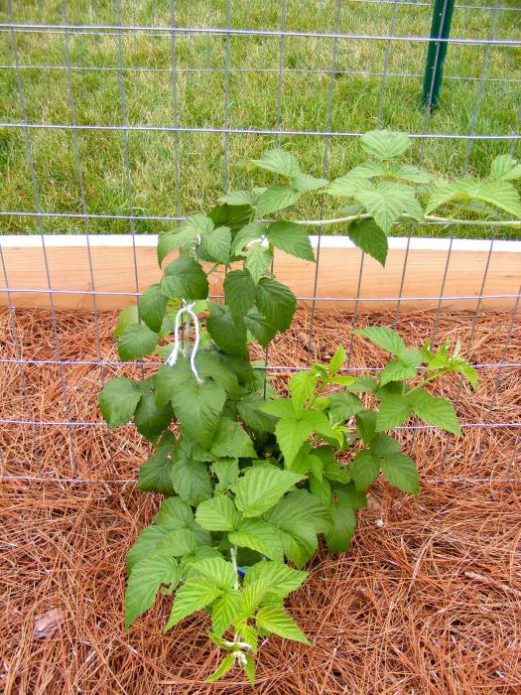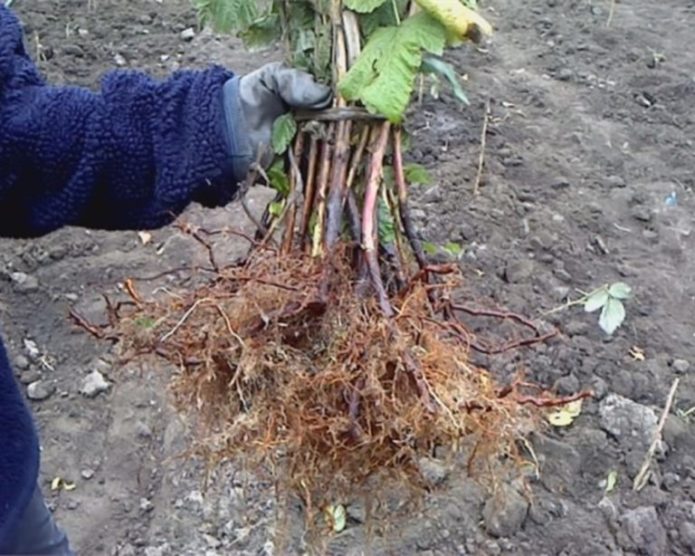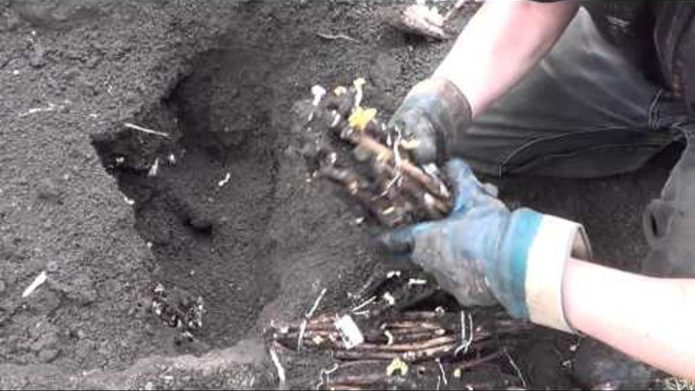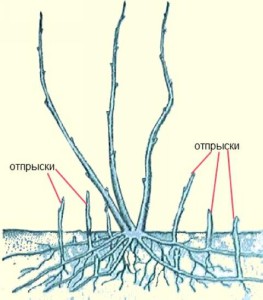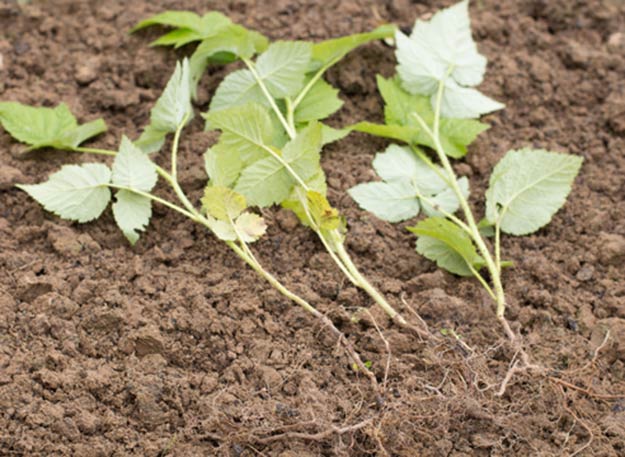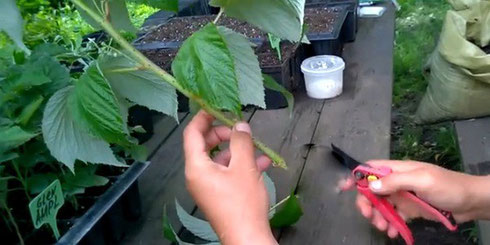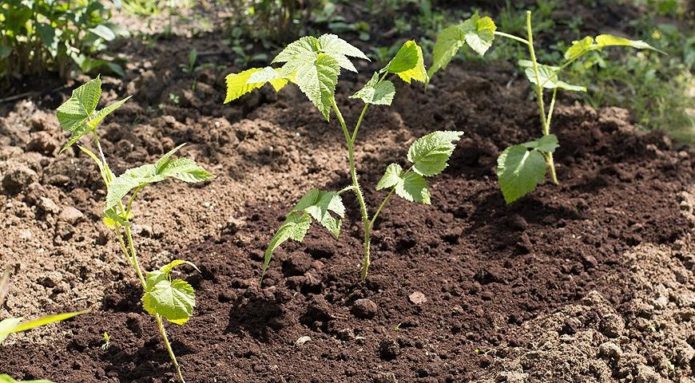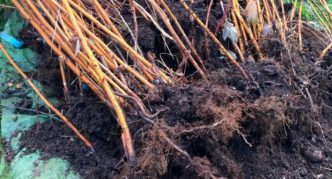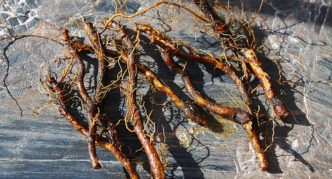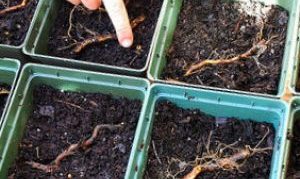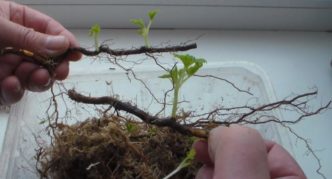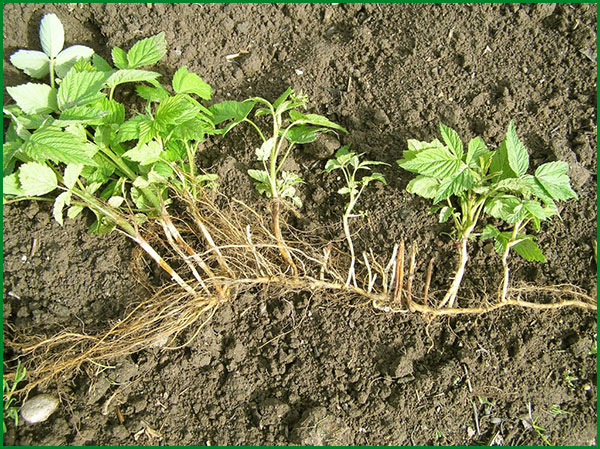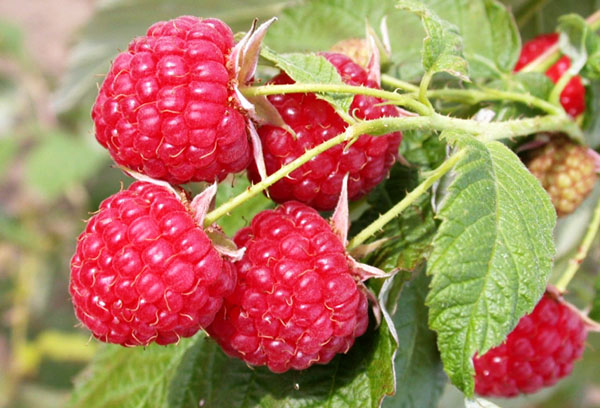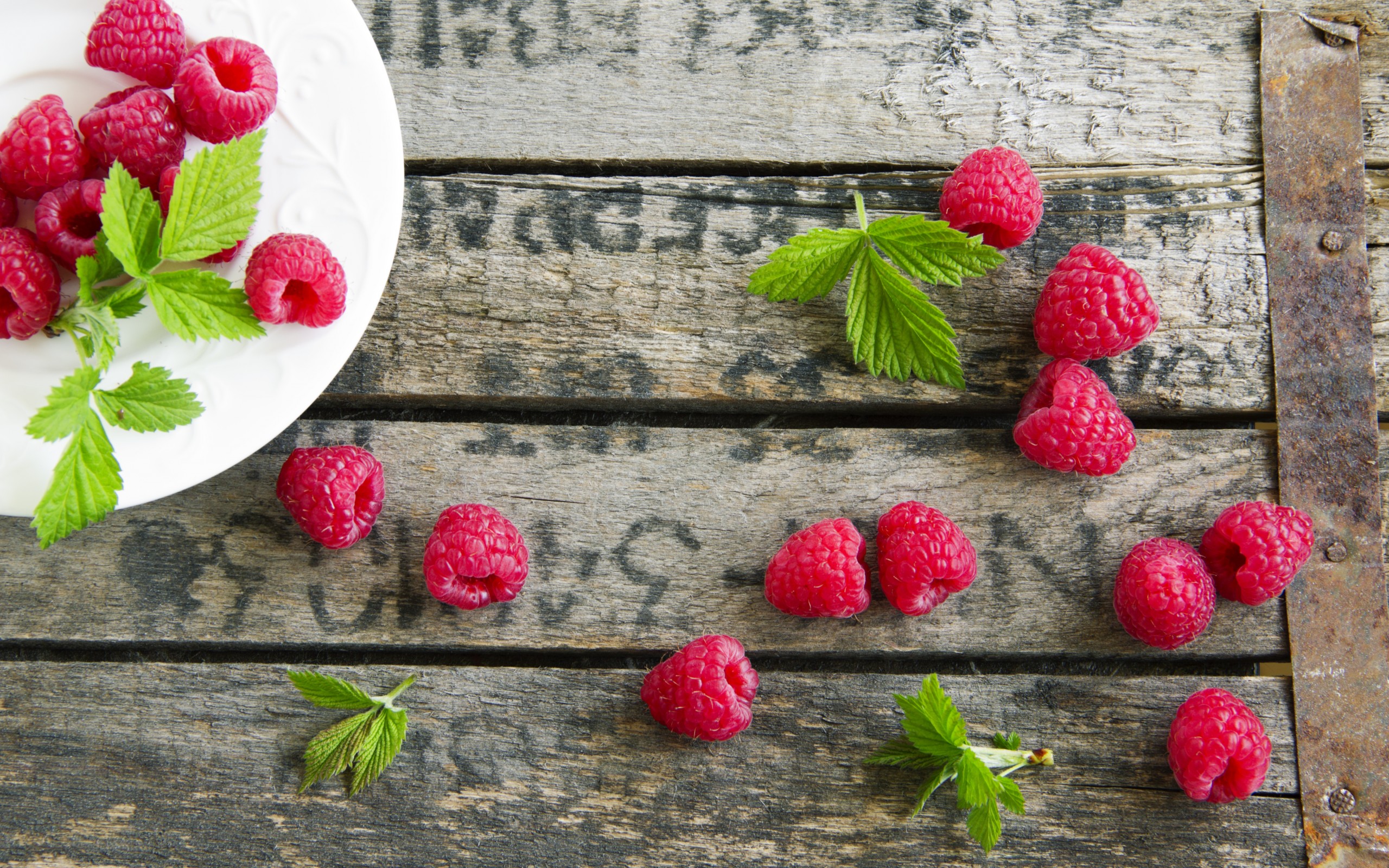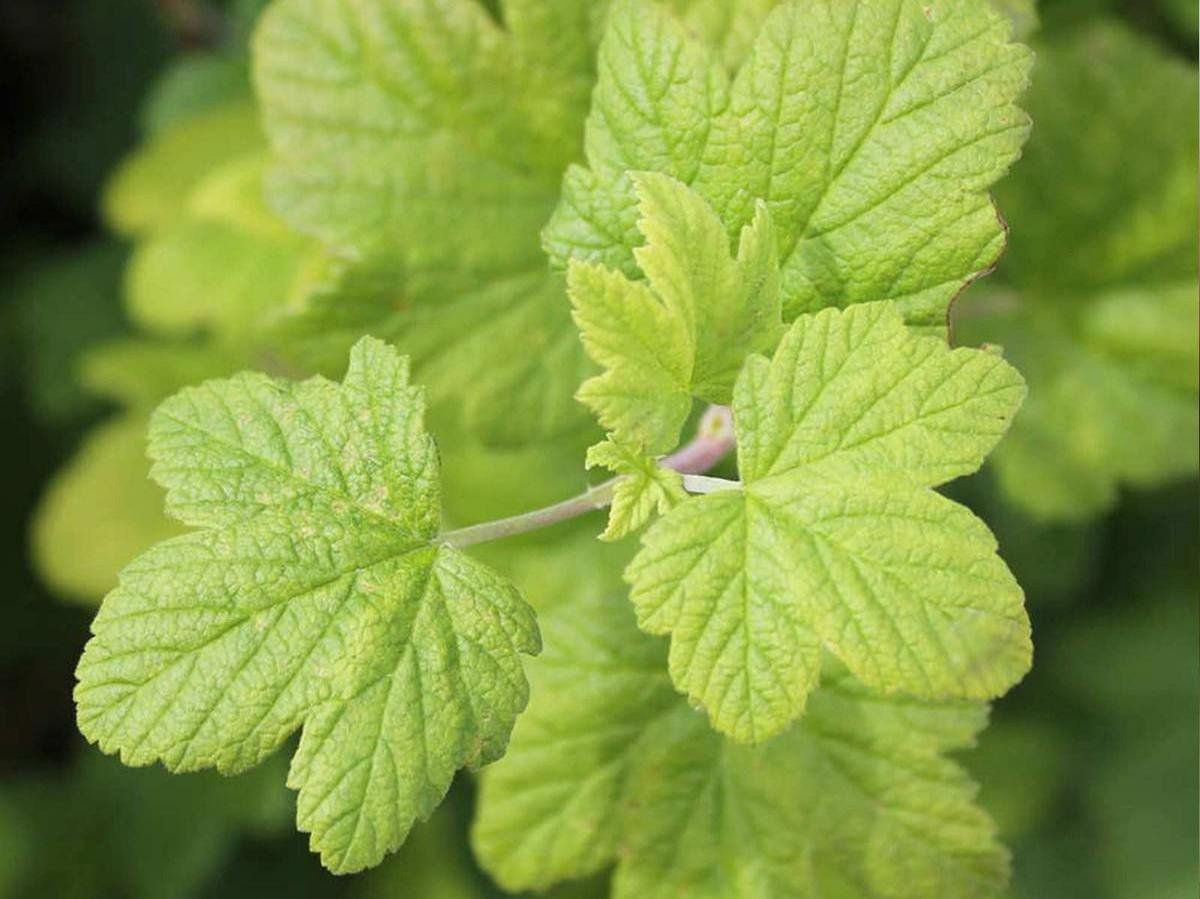Before talking about raspberry cuttings, you should define the meaning of the word "cutting". According to S. Ozhegov's dictionary, this is "a small piece of shoot with buds from a fruit tree or bush, used for grafting or planting." As you know, a shovel also has its own stalk, and if it ever blooms, then we can talk about a miracle. In the meantime, only about raspberry cuttings.
Content
Cutting as a process of harvesting planting material
Cutting is one of the fastest, most efficient and cost effective methods of plant propagation. It is suitable for many fruit and berry bushes. At the same time, there is a 95% guarantee that a culture that develops from parental material will not lose its maternal genetic properties - and this is what often happens with the seed form of reproduction.
In the case of raspberries, cuttings are considered the main form of vegetative reproduction. The essence of the method consists in the selection of lignified or green cuttings, which, depending on the time of taking the material, ripen and take root under suitable conditions from 3 weeks to 6 months, after which they are planted in open ground.
The "suitable conditions" in this case include the humidity-temperature regime, and the composition of the soil / water for rooting, and the intensity of light. So, to ensure sufficient moisture during the ripening period of cuttings, many gardeners have even adapted to use a fogging device, which saves raspberry shoots from too dry air, typical for the heating season in most regions of Russia.
Cutting methods
Raspberry propagation is available in many ways, including root division, seed, top layering. However, cuttings have gained the greatest popularity among gardeners. This simple and reliable method has proven to be effective almost throughout the growing season: spring, summer and fall. And based on the time of year, its classification also appeared:
- autumn cuttings with lignified shoots;
- spring root cuttings;
- summer cuttings with green shoots;
- autumn root cuttings in Scottish style.
Winter did not stand aside either. The cold period became a temporary cushion that allowed the plant to rest before adapting to a new life that requires a lot of strength and energy to continue growing.
Whichever method of cutting cuttings you choose, you should remember the following.
Before cutting the cuttings, the bush must be checked for health.It should not show any signs of disease: no withered or shriveled leaves, no spots or holes in the foliage, no growths on the bark, no traces of insects. If unhealthy signs of a plant are detected, then it and the bushes adjacent to it at a distance of up to 2 meters are taken into quarantine. This means not only medicinal spraying of all the bushes of the plot, but also their subsequent simple operation under strict supervision, even without a hint of selection of cuttings.
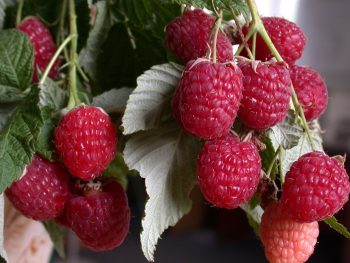
Glossy foliage, sturdy wood without outgrowths and whole raspberries are signs of a healthy shrub ready to propagate
Autumn cuttings
The method of harvesting cuttings in the fall is used for almost all varieties of raspberries. Bushes at the age of 3-4 years serve as mother plants, in which strong shoots are determined - from them, segments of already stiff trunks are taken.
Cutting cuttings and winter storage
The best time to select cuttings is September. The recommended cutting length is 25–30 cm with 3-4 buds available. Cuts are made at an angle of 450 - such a technique in the future will allow you to properly plant the cuttings in the ground, which will contribute to their good nutrition, regulation of humidity and heat.
The further procedure for winter storage of cuttings depends on the climatic conditions of the region in which the raspberry grows.
- If the winters in the region are mild and snowy, and outside temperatures do not drop below +150C, then storage of cuttings is allowed in the ground at a depth of 80–90 cm. Before placing the cuttings for storage in a pit, they should be wrapped in a canvas cloth and put in a box with sand. The planting material is extracted in February - March, after the ground has thawed.
- If the region is prone to low winter temperatures, and the ground freezes to a depth of over 1 meter, then it is better to store the cuttings in a cool basement or cellar. The sand box will come in handy in this case too. The planting material is retrieved from its shelter in February.
Spring revitalization of cuttings
With the onset of an active drop on the street, cuttings are taken from their winter shelter. After they undergo adaptation to the new temperature conditions, the lower cut must be updated by shortening it with a secateurs by 1 cm, and then place all the updated cuttings in a jar with settled water at room temperature for 12 hours. This is required in order to set in motion all the internal juices and forces of the plant.
The next step is to prepare a life-giving solution with a root growth stimulator, which is performed according to the manufacturer's instructions. It can be succinic acid, heteroauxin, root, zircon. The lower tip of the cutting is placed in the nutrient medium of the stimulator, where it will spend the next 3 weeks until the first roots appear. Creating a greenhouse effect from a film or glass above the container will accelerate the maturation of the roots.
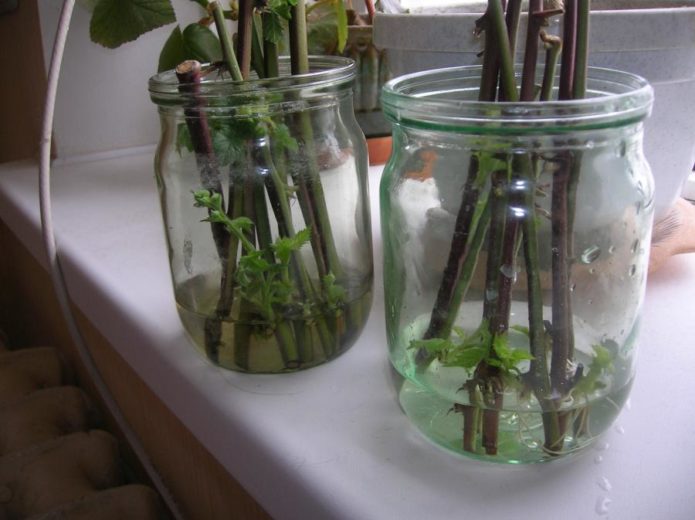
In February-March, cuttings harvested from autumn are placed in a nutrient solution that promotes root formation
After rooting, the cuttings are planted either in open ground, if climatic and weather conditions permit, or in room containers for ripening in greenhouse conditions.
The soil under the young roots should be gentle, but at the same time nutritious, so that growth is not inhibited. For these purposes, a mixture of garden soil, sand and peat at the rate of 2: 1: 1 is suitable. Watering and feeding during this period is required.
Spring cuttings
The spring reproduction of raspberries, in contrast to the autumn, is not a shock phenomenon at all. With the heat of the sun, cuttings taken with a part of the root root well and tolerate all external adverse influences more easily.
Lateral branches or offshoots
Another name for such cuttings is lateral layers or offshoots.They grow in the internodes of the horizontal roots of raspberries, and since these roots are located underground at different depths, the appearance of lateral layers also occurs not simultaneously in a certain season, but throughout the entire growing season. However, summer cuttings are not considered as planting material, since in a warm dry period, barely visible roots may not reach the nutrient layer of the earth and die.
There can be a lot of such layers in one bush, and if they are not required for reproduction, then it is recommended to remove them so that they do not pull food from the main stem.
Agricultural techniques for planting side layers
Having separated the layers 7–10 cm high from the mother bush with sharp tools, they arrange it in a prepared nest so that the small roots enter it neatly. Usually the depth of such a nest is 10–12 cm.
The cutting is covered with fertile soil, but the root collar remains on the surface. The plant is watered abundantly and covered with foil for the first week. After the appearance of a green growth, the shelter is removed, and the ingrown stalk is fed with nitrogen-phosphorus-potassium fertilizers. A young plant during this period is very delicate and vulnerable, so protection from cold winds and scorching sun rays will be useful. Fruiting will come the next year after rooting.
Summer cuttings
For the summer procedure, cuttings are taken from young shoots that have not yet become stiff. This is a very fertile material, because the ability to form roots in green cuttings is stronger than in branches with a lignified structure.
Two features of summer cuttings
There are two features of summer raspberry cultivation.
- The first is that green shoots contain much less nutrients than mature cuttings. Therefore, long-term storage of green material is impossible.
- The second feature reflects the balance of forces: first, those that are in the handle itself; then those that form in the roots. Therefore, it is important to do everything for growth before the first strength runs out. If this happens before the formation of the root system, the plant will die.
Selection of summer cuttings
The selection method for summer cuttings is very similar to the spring cuttings described above. The only difference is that the green shoots-layers are not undermined with a part of the horizontal root, but are cut off with a pruner at the very ground level or with a slight depth of 1 cm.
The upper edge of the stem is leveled to a length of 8–10 cm, and its lower part is placed in a nutrient aqueous solution with a root stimulator. After 12 hours, the petiole is removed from the solution and planted on a planting bed under a film. Such a micro-greenhouse will create all the necessary conditions for growth and rooting, namely constant humidity and a temperature of 23-250FROM.
Development of cuttings in the first month after planting
Distances of 10–12 cm between the cuttings are enough to make them feel comfortable and spacious. To maintain the moisture level, daily watering is recommended.
The first green shoots will appear about a month after planting. A period of shoot growth and root branching will begin. At this stage it is recommended to remove the film cover during the daytime, leaving it only overnight. Watering frequency is also reduced. After another month, the grown and rooted shoots can be transplanted to a permanent place of residence in fertilized fertile soil.
Scottish raspberry propagation
The method described below is called Scottish in Internet sources, since it was first described in the Scottish agrotechnical literature. How true are the statements that as a result you can get 200 seedlings from one bush, I do not undertake, because I myself have not tried and I have not seen people who have achieved such a result. But, nevertheless, the very technique of reproduction, with or without reliable results, deserves attention.
Seasonal preparation of bushes
The method is believed to be applicable to remontant raspberry varieties that yield both annual and biennial shoots. Culture, therefore, wastes a lot of energy. And autumn pruning "under the root" and cuttings in the Scottish way contribute to the replenishment of these forces, intensive growth and future fruiting.

The root system of remontant raspberries is capable of producing a large number of buds - which is why they are good for Scottish breeding.
The preparation of raspberry bushes for reproduction begins already with the onset of the growing season. In order for the kidney rudiments to grow on the underground parts of the stem by autumn, it is necessary to mulch the bushes with sawdust, humus or peat from spring. At the same time, the mulch is supplemented and renewed two to three times during the season.
Cutting root cuttings and their winter storage
In September - October, before the onset of frost, the bushes are dug up. The root part of the stem, which grew underground, is cut into cuttings 15–18 cm long and, after an hour of disinfection in a weak solution of potassium permanganate, is placed in boxes, alternating with moss. It will nourish the roots throughout the winter, moisturize and warm them with its warmth. The boxes are placed in a cellar with a storage temperature not higher than +50C, or tightly wrapped with a cloth, buried in the greenhouse to a depth of 40-50 cm. For safety reasons, the storage place is covered with straw, dry peat or any other garden insulation, except polyethylene.
Photo gallery: Scottish cuttings
- After cleaning the root trunks from the ground, you can start cutting root cuttings
- The optimal length of cuttings is 15–18 cm - a size suitable for agricultural containers
- Raspberry root cuttings are placed horizontally in the substrate so that as many kidney embryos laid down by nature grow over their entire surface
- These young shoots were grown on horizontally planted roots according to the Scottish method.
After thawing of the ground, in March - April, the boxes are brought into a warm room. The extracted cuttings, without any preliminary soaking, are placed horizontally in seedling containers filled with a fertile substrate. The resulting incubator is watered and covered with glass, creating a greenhouse effect. The temperature in the incubator can vary from +16 to +200FROM.
Planting cuttings and collecting shoots
After 3 weeks, root buds along the entire length of the buried cutting will give the first shoots. Then the film or glass is removed. The sprouts begin to gain strength, and when 2-3 true leaves appear on them, a new cut is made with a sharp knife, processed from microbes. The place of the cut should not be under the stalk of the sprout, but with the capture of the so-called white "heel". The lower tip of the sprout is dusted with wood ash and planted in the next box with the same substrate.
From that moment on, the seedlings are looked after as for ordinary seedlings, watering and feeding them with combined mixtures, which contain a full range of all minerals necessary for growth. Air temperature 25-260C is quite suitable for this period. After reaching a growth point of 15–20 cm, the seedlings are planted on a raspberry plot in open ground.
Scotch raspberry seasonal work table
The schedule of the full cycle of seasonal work on the reproduction of raspberries in the Scottish way fits perfectly into the table format.
| May | End of September-October | Winter | Second decade of March | April | |
| Planting grown seedlings in open ground Mulching of adult bushes | Mulch promotes the formation of kidney embryos. | ||||
| Cutting the underground part of the stem into cuttings | Cuttings length 15-18 cm | ||||
| Storage of planting material in the cellar or in the ground | Storage temperature not higher than +50FROM. | ||||
| Placing cuttings in a nutritious soil substrate | Cuttings are laid horizontally. | ||||
| Harvesting young shoots and planting them in nursery greenhouses | Heel sprouts are cut every 2-3 days. |
The whole secret of this progressive method is that cutting from a buried cutting can be done for a whole month as new shoots appear, which grow like mushrooms after rain. At least that's how it is announced. It is easy to calculate that when cutting off at least 2-3 shoots every other day on a 15-centimeter cutting, theoretically you can get from 25 to 50 new seedlings per month. “Quasi-uno-fantasy,” as one popular movie hero would say, is a classic.
Thus, every gardener can breed raspberries on their site. Depending on the weather conditions and the time of year, you can choose the appropriate type of cuttings and start preparing for it already with the onset of spring. Raspberries are not such a difficult crop for agricultural technology. Hardy and tenacious even in dense forest thickets, it practically grows and reproduces itself. One has only to push her a little to this independent action.
